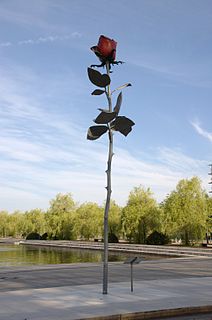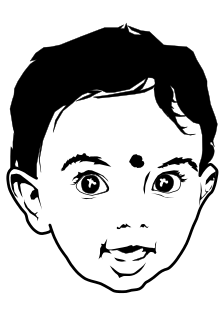Related Research Articles

Contemporary art is the art of today, produced in the second half of the 20th century or in the 21st century. Contemporary artists work in a globally influenced, culturally diverse, and technologically advancing world. Their art is a dynamic combination of materials, methods, concepts, and subjects that continue the challenging of boundaries that was already well underway in the 20th century. Diverse and eclectic, contemporary art as a whole is distinguished by the very lack of a uniform, organising principle, ideology, or "-ism". Contemporary art is part of a cultural dialogue that concerns larger contextual frameworks such as personal and cultural identity, family, community, and nationality.

Installation art is an artistic genre of three-dimensional works that are often site-specific and designed to transform the perception of a space. Generally, the term is applied to interior spaces, whereas exterior interventions are often called public art, land art or art intervention; however, the boundaries between these terms overlap.

Derrick de Kerckhove is the author of The Skin of Culture and Connected Intelligence and Professor in the Department of French at the University of Toronto, in Toronto, Ontario, Canada. He was the Director of the McLuhan Program in Culture and Technology from 1983 until 2008.

David Rokeby is an artist who has been making works of electronic, video and installation art since 1982. He lives with his wife, acclaimed pianist Eve Egoyan, and daughter, Viva Egoyan-Rokeby, in Toronto, Canada.

The Rokeby Venus is a painting by Diego Velázquez, the leading artist of the Spanish Golden Age. Completed between 1647 and 1651, and probably painted during the artist's visit to Italy, the work depicts the goddess Venus in a sensual pose, lying on a bed and looking into a mirror held by the Roman god of physical love, her son Cupid. The painting is in the National Gallery, London.
InterAccess is a Canadian artist-run centre and electronic media production facility in Toronto. Founded in 1982 as Toronto Community Videotex, InterAccess is Ontario's only exhibition space devoted exclusively to technological media arts. The Centre for Contemporary Canadian Art places the founding of InterAccess as a key moment in both the history of Canadian electronic art but also within a timeline of developments in international art, science, technology and culture.

Norman White Canadian New Media artist considered to be a pioneer in the use of electronic technology and robotics in art.

Doug Aitken is an American artist. Aitken was born in Redondo Beach, California in 1968. Aitken's body of work ranges from photography, print media, sculpture, and architectural interventions, to narrative films, sound, single and multi-channel video works, installations, and live performance.

Maurice Benayoun is a French new-media artist, curator, and theorist based in Paris and Hong Kong.

Fred Forest is a French new media artist making use of video, photography, the printed press, mail, radio, television, telephone, telematics, and the internet in a wide range of installations, performances, and public interventions that explore both the ramifications and potential of media space. He was a cofounder of both the Sociological Art Collective (1974) and the Aesthetics of Communication movement (1983).

Francesco Monico is a teacher, researcher, artist in Italy.

The MacKenzie Art Gallery is an art museum located in Regina, Saskatchewan, Canada. The museum occupies the multipurpose T. C. Douglas Building, situated at the edge of the Wascana Centre. The building holds eight galleries totaling to 2,200 square metres (24,000 sq ft) of exhibition space.
The Toronto School is a school of thought in communication theory and literary criticism, the principles of which were developed chiefly by scholars at the University of Toronto. It is characterized by exploration of Ancient Greek literature and the theoretical view that communication systems create psychological and social states. The school originated from the works of Eric A. Havelock and Harold Innis in the 1930s, and grew to prominence with the contributions of Edmund Snow Carpenter, Northrop Frye and Marshall McLuhan.

Angel_F is a fictional child artificial intelligence that has been used in art performances worldwide focused on the issues of digital liberties, intellectual property and on the evolution of language and behaviour in information society. The character was created by Salvatore Iaconesi in 2007 as a hack to the Biodoll art performance by Italian artist Franca Formenti.

Internet art is a form of new media art distributed via the Internet. This form of art circumvents the traditional dominance of the physical gallery and museum system. In many cases, the viewer is drawn into some kind of interaction with the work of art. Artists working in this manner are sometimes referred to as net artists.
Robert Adrian (1935–2015), also known as Robert Adrian X, was a Canadian artist who made radio and telecommunications art. Adrian moved from Canada to Vienna, Austria in 1972 where he became known for creating experimental artworks using radio and communications technologies. His work The World in 24 Hours, which connected artists in different cities and continents through telephone lines and radio, is considered to be one of the first experiments in online culture. Adrian is considered to be a pioneer in the field of telecommunications art and media art.

Maurizio Bolognini is a post-conceptual media artist. His installations are mainly concerned with the aesthetics of machines, and are based on the minimal and abstract activation of technological processes that are beyond the artist's control, at the intersection of generative art, public art and e-democracy.

New media art includes artworks designed and produced by means of electronic media technologies, comprising virtual art, computer graphics, computer animation, digital art, interactive art, sound art, Internet art, video games, robotics, 3D printing, and cyborg art. The term defines itself by the thereby created artwork, which differentiates itself from that deriving from conventional visual arts. New Media art has origins in the worlds of science, art, and performance. Some common themes found in new media art include databases, political and social activism, Afrofuturism, feminism, and identity, a ubiquitous theme found throughout is the incorporation of new technology into the work. The emphasis on medium is a defining feature of much contemporary art and many art schools and major universities now offer majors in "New Genres" or "New Media" and a growing number of graduate programs have emerged internationally. New media art may involve degrees of interaction between artwork and observer or between the artist and the public, as is the case in performance art. Yet, as several theorists and curators have noted, such forms of interaction, social exchange, participation, and transformation do not distinguish new media art but rather serve as a common ground that has parallels in other strands of contemporary art practice. Such insights emphasize the forms of cultural practice that arise concurrently with emerging technological platforms, and question the focus on technological media per se. New Media art involves complex curation and preservation practices that make collecting, installing, and exhibiting the works harder than most other mediums. Many cultural centers and museums have been established to cater to the advanced needs of new media art.

Diana Burgoyne is a Canadian artist known for her installations and performance works using handmade electronics.
Max Dean is a Canadian multidisciplinary artist.
References
- ↑ "Artist/Maker Name "Back, Doug"". Canadian Heritage Information Network. Retrieved 27 May 2016.
- ↑ "Doug Back". Aspect: The Chronicle of New Media Art. Retrieved 27 May 2016.
- ↑ "Caroline Langill Interview with Doug Back". Daniel Langlois Foundation for Art, Science and Technology. Retrieved 27 May 2016.
- ↑ Derrick De Kerckhove (1998). Connected Intelligence: The Arrival of the Web Society. Kogan Page. ISBN 978-0-7494-2780-1.
- ↑ Derrick de Kerckhove (2000). L'intelligence des réseaux. Odile Jacob. pp. 97–. ISBN 978-2-7381-0896-8.
- ↑ Louise Poissant; Pierre Tremblay (1 January 2010). Ensemble Ailleurs. PUQ. pp. 141–. ISBN 978-2-7605-2486-6.
- ↑ Turner, Jeremy. "INTERVIEW WITH NORMAN WHITE ABOUT EARLY TELEMATIC ART AT OPEN SPACE GALLERY IN VICTORIA, CANADA". Open Space. Archived from the original on 2011-07-09. Retrieved 28 May 2016.
- ↑ Anna-Teresa Tymieniecka (30 June 2006). Human Creation Between Reality and Illusion. Springer Science & Business Media. pp. 123–. ISBN 978-1-4020-3578-4.
- 1 2 "Doug Back". V2_Institute for the Unstable Media. Retrieved 27 May 2016.
- ↑ David Rokeby; Sara Diamond; Su Ditta (2004). David Rokeby. Oakville Galleries.